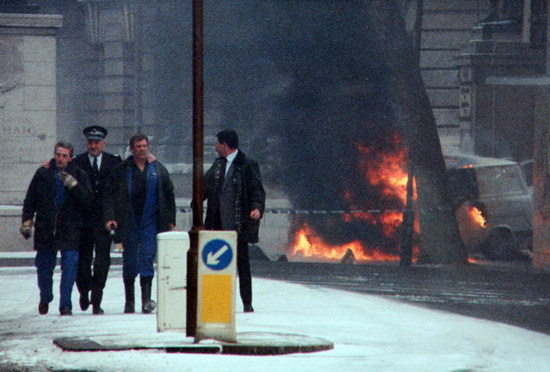
Salah Abdeslam, the sole survivor of a 10-man ISIS cell that carried out the November 2015 coordinated terrorist attacks across Paris, went on trial today in his hometown of Brussels. He was arrested in March 2016 in the Belgian neighborhood where he and many of those in his ISIS cell had grown up.
As the Israeli newspaper Haaretz reports, the successful 2015 attacks in Paris, and a few days later in Belgium, were made possible by ISIS’ success in wedding the skill set of criminals with religious radicalization and ultimately terrorism:
Abdeslam, who along with his brother was suspected of dealing drugs from the bar they ran, is the starkest example of that convergence. But in Paris, the trial of three men accused of giving safe haven to the attackers also provides a revealing look at the intersection that made possible the deadliest terror attacks in Europe since World War II.
The operational commander of the cell was Abdelhamid Abaaoud, a petty criminal who used his home neighborhood of Molenbeek in Brussels as a fertile recruiting ground for Islamic State. Abaaoud even recruited his younger brother, then 14. But many of the young men who followed him into Islamic State were small-time criminals themselves, part of the extremist organization’s deliberate attempt to make use of “skills” that include accessing black market weapons, forging documents and handling covert logistics. …
But the lines between terrorists and criminals are less clear now than ever, said Peter Neumann, director of the International Centre for the Study of Radicalisation.
“ISIS is perhaps the first jihadist group that has explicitly targeted this demographic, and thy’ve done it very consciously and especially in Europe,” he said. “What we saw in Brussels and Paris — this is not an isolated case. This is actually reflecting the situation across Europe. If you go to Sweden, Norway, Holland, Germany, they will all tell you that 50 percent plus of the people who have turned up traveling to Syria or involved in domestic plots have previous criminal convictions, often for petty crime.”
Now on to this week’s look back:
- Feb. 6, 2004 — Moscow: An unknown group detonates explosives on the metro, killing 40 and wounding 122.
- Feb. 7, 1991 — London: The Irish Republican Army launches a mortar attack on the 10 Downing Street, the official residence and offices of the prime minister, during a meeting of the British cabinet. There were no injuries. The homemade weapons were fired from the back of a van parked nearby, with at least one projectile detonating in the rear garden of Number 10, damaging the building with shrapnel.
- Feb. 8, 2002 — Montana: The leader of a militia group, calling itself Project 7, and his girlfriend are arrested and charged with plotting to assassinate judges and law enforcement officers in order to trigger a revolution. Authorities recover pipe bombs, 25,000 rounds of ammunition, and “intel sheets” with personal information on law enforcement officers, their spouses, and children.
- Feb. 9, 2009 — Sri Lanka: An LTTE female suicide bomber kills 28 and wounds 90 in an attack in Vishvamadu.
- Feb. 10, 2011 — Marden, Pakistan: A suicide bomber kills 27 soldiers in an attack on a military training center. Tehrik-i-Taliban Pakistan claims responsibility.
- Feb. 11, 1974 — Newtownabbey, Northern Ireland: Two Catholic civilians are shot as they arrive for work and are killed by the Ulster Freedom Fighters, which was a cover name used by the Ulster Defense Association.